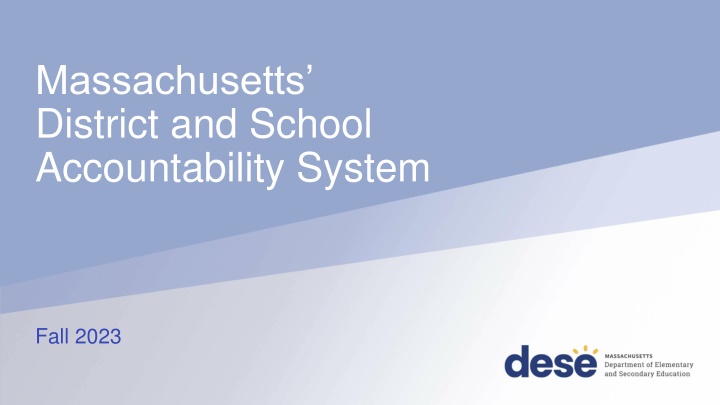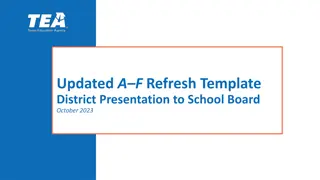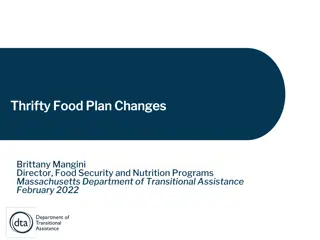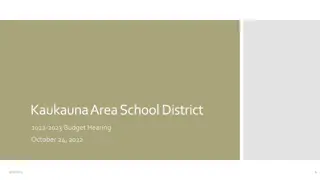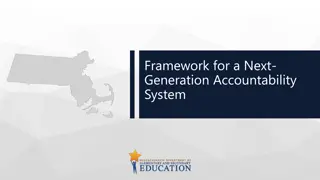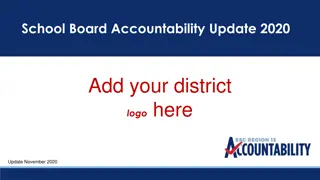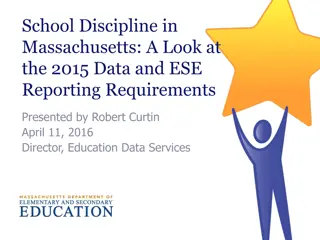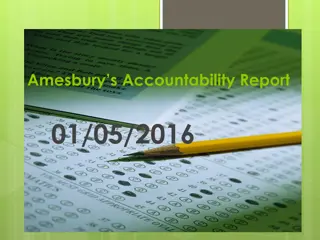Massachusetts District and School Accountability System Fall 2023
The Massachusetts District and School Accountability System for Fall 2023 includes various components such as Accountability Indicators, Normative Component, Criterion-Referenced Component, Assessment Participation, Categorization of Schools and Districts, and Reporting. It emphasizes measuring the performance of schools and districts, categorizing them based on performance levels, and providing targeted support. The system focuses on indicators like Achievement, English Learner Proficiency, Student Growth, and High School Completion, aiming to track progress and ensure accountability across educational institutions.
Download Presentation

Please find below an Image/Link to download the presentation.
The content on the website is provided AS IS for your information and personal use only. It may not be sold, licensed, or shared on other websites without obtaining consent from the author.If you encounter any issues during the download, it is possible that the publisher has removed the file from their server.
You are allowed to download the files provided on this website for personal or commercial use, subject to the condition that they are used lawfully. All files are the property of their respective owners.
The content on the website is provided AS IS for your information and personal use only. It may not be sold, licensed, or shared on other websites without obtaining consent from the author.
E N D
Presentation Transcript
Massachusetts District and School Accountability System Fall 2023 1
Topics 1. Summary of the 2023 Accountability System 2. Accountability Indicators 3. Normative Component 4. Criterion-Referenced Component 5. Assessment Participation 6. Categorization of Schools and Districts 7. Reporting 8. Reporting Timeline and Resources 2
1. Summary of the 2023 Accountability System 3 3
Refresher: MA Accountability System 101 that measure performance of groups, schools, and districts on specific indicators 2 The Massachusetts accountability system consists of two components 1 Achievement English Learner Proficiency Student Growth Additional Indicators High School Completion Normative Component (Accountability Percentile) measures the performance of all students in a school compared to other schools in the state that serve similar grades, and is reported as a percentile from 1 to 99 3 and are used categorize schools and districts as requiring assistance/intervention or not. Criterion-Referenced Component (Targets) Not requiring assistance or intervention Requiring assistance or intervention Focused/ targeted support Schools of recognition Moderate progress toward targets Limited or no progress toward targets Broad/ Meeting or exceeding targets Substantial progress toward targets comprehensive support measures a district s or school s progress towards improvement targets, and is reported as a percentage Recognized for high achievement, high growth, meeting/ exceeding targets Cumulative criterion- referenced target percentage 25-49 Cumulative criterion- referenced target percentage 0-24 Underperforming schools Chronically underperforming schools Cumulative criterion- referenced target percentage 75-100 Cumulative criterion- referenced target percentage 50-74 Percentiles 1-10 Low graduation rate Low performing group(s) Low participation 4
Overview: 2023 Accountability Reporting Represents a return to the full accountability system (first time since 2019) Reports include: Performance of the lowest performing students group Progress toward improvement targets School and student group percentiles Overall classifications Schools of recognition 5
Recent History of Accountability Measures Reported Measure 2019 2020 2021 2022 2023 Accountability Percentile Progress Towards Targets 6
Indicators in Accountability System Indicator Measure English language arts (ELA) average composite scaled score Math average composite scaled score Science average composite scaled score ELA mean student growth percentile (SGP) Math mean SGP Four-year cohort graduation rate Extended engagement rate (five-year cohort graduation rate plus the percentage of students still enrolled) Annual dropout rate Achievement Student Growth High School Completion English Language Proficiency Progress made by students towards attaining English language proficiency (percentage of students in grades 1- 12 meeting annual targets required in order to attain English proficiency in six years) Chronic absenteeism (percentage of students in grades 1-12 missing 10% or more of their days in membership) Percentage of 11thand 12thgraders completing at least one advanced course (Advanced Placement, International Baccalaureate, Project Lead the Way, dual enrollment for credit, Ch. 74-approved voc/tech cooperatives and articulation agreement courses, and/or other rigorous courses) Additional Indicator(s) Note: To report data for an indicator, results must be available for at least 20 students in multiple years. 8
Weighting of Indicators: Non-High Schools Weighting (3:1) With EL Indicator Measures No EL ELA, math, and science MCAS average composite scaled scores Achievement 60% 67.5% Student Growth ELA and math SGPs 20% 22.5% English Language Proficiency Percent of ELs making progress towards attaining English language proficiency 10% Additional Indicators Chronic absenteeism rate 10% 10% 9
Weighting of Indicators: High Schools Weighting (3:1) With EL Indicator Measures No EL Achievement ELA, math, and science average scaled score 40% 47.5% Student Growth ELA and math SGPs 20% 22.5% Four-year cohort graduation rate Extended engagement rate Annual dropout rate Percent of ELs making progress towards attaining English language proficiency High School Completion 20% 20% English Language Proficiency 10% Chronic absenteeism rate Advanced coursework completion rate Additional Indicators 10% 10% Note: The high school completion indicators are considered part of achievement when measuring the ratio of achievement to growth 10
3. Normative Component (Accountability Percentile) 11 11
Overview: Normative Component Accountability percentile 1-99, calculated using all available indicators for a school Compares schools within one of three groups: Non-high schools Middle/High/K-12 schools High schools Used to identify the lowest performing schools in the state, as required by state and federal laws Same calculation used at the student group level to identify low performing student groups Weighted average of 2022 data (40%) and 2023 data (60%) 12
School Comparison Groups Schools are grouped and compared based on the grades served in 2023: Non-High Schools Middle/High/K-12 Schools High Schools Serving only a combination of grades 3-8 Serving grade 10 and at least one other grade 3-8 Schools in which the only tested grade is grade 10 13
Comparing Percentiles Across Years and Grades Do not compare 2023 accountability percentiles school percentiles from 2012-2017 Use caution when comparing 2018, 2019, 2022, and 2023 percentiles Percentiles were not calculated in 2020 and 2021 Do not compare percentiles across gradespans Compare a non-high school to another non-high school Compare a non-high school to a middle/high or K-12 school 14
4. Criterion-Referenced Component (Targets) 15 15
Overview: Criterion-Referenced Component Federal law requires long-term goals and measures of interim progress DESE calculates targets for each district, school, and student group 2023 targets for the achievement indicators were published this past spring and were determined by the district, school, or group s path Recovery Path: The MCAS average scaled score for a group/subject was higher in 2019 than in 2022 Path Forward: The MCAS average scaled score for a group/subject was higher in 2022 than in 2019, or the improvement increment calculated using the recovery path for the group and subject is less rigorous than that assigned in 2019 Targets for non-assessment indicators are based on analysis of past trends and reasonable expectations for improvement Points are assigned based on progress toward each indicator s target Overall progress towards targets is reported as a percentage 16
Scale of Point Assignment Points assigned based on progress toward target for each indicator for the all students group and each student group with sufficient data: No Improved below target 2 Met target 3 Exceeded target 4 Category Declined change 1 Points 0 Target % 0% 25% 50% 75% 100% 17
Lowest Performing Student Group In addition to school results, DESE will also measure the performance of the lowest performing students in each school Every school has a group of lowest performers Identified from a group of students who have been enrolled in the school for more than one year Exception in 2023: no lowest performing group in grade 10 For most schools serving grades 3-8, eligible students were: Officially enrolled and tested in their current school or district for two consecutive years; Not a first- or second-year English learner in 2023 Not assessed using MCAS-Alt in both ELA and math The lowest performing group represents the lowest performing 25 percent of eligible students, identified using a combined 2022 ELA and math average scaled score In schools where a legitimate cohort cannot be identified (fewer than 20 students), accountability results will be based on the performance of the all students group only 18
Sample Criterion-Referenced Component Calculation (Non-High School) All students (50%) Lowest performing students (50%) Indicator Points earned Total possible points Weight (%) Points earned Total possible points Weight (%) ELA MCAS average composite scaled score 1 4 - 0 4 - Math MCAS average composite scaled score 3 4 - 3 4 - Science MCAS average composite scaled score 4 4 - - - - Achievement total 8 12 60.0 3 8 67.5 ELA Student Growth Percentile 2 4 - 2 4 - Math Student Growth Percentile 3 4 - 2 4 - Growth total 5 8 20.0 4 8 22.5 EL progress 2 4 10.0 - - - Chronic absenteeism 4 4 10.0 2 4 10.0 6.4 9.6 - 3.1 7.6 - Weighted total 67% 41% Percentage of possible points Criterion-referenced target % 54% 19
Sample Criterion-Referenced Component Calculation (High School) N/A in 2023 All students (100% in 2023) Lowest performing students Indicator Points earned Total possible points Weight (%) Points earned Total possible points Weight (%) ELA MCAS average composite scaled score Math MCAS average composite scaled score Science MCAS average composite scaled score Achievement total ELA Student Growth Percentile Math Student Growth Percentile Growth total Four-year cohort graduation rate Extended engagement rate Annual dropout rate High school completion total EL progress Chronic absenteeism Advanced coursework completion Additional indicators total Weighted total Percentage of possible total points Criterion-referenced target % 4 4 3 11 2 1 3 3 3 3 9 3 4 2 6 7.7 4 4 4 - - - - - - - - - - - - - - - - - - - - - - - - - - - - - - - - - - - - - - - - - - - - - - - - - - - - 12 4 4 8 4 4 4 12 4 4 4 8 10.0 40.0 - - 20.0 - - - 20.0 10.0 - - 10.0 - - 77% - 77% 20
Overview: Assessment Participation Districts and schools are required to maintain a 95 percent participation rate for the district/school as a whole and for each student group Calculation includes: ELA, math, and science MCAS ACCESS for ELLs (included in ELA rate) Rate for All Students calculated separately for ELA, math, and science Rate for each student group represents the percentage of all tests combined Calculated two ways, with higher rate used in determination: Actual 1-year rate for current year, and Combined 2-year rate (if actual 1-year rate is less than 95 percent) 22
6. Categorization of Schools and Districts 23 23
Overview: Categorization of Schools Accountability determinations for schools will be based on 5 factors: Accountability percentile (1-99) Criterion-referenced target percentage (0-100%) Student group performance (Student group percentile 1-99) Graduation rate (if less than 66.7%) Assessment participation (if less than 95%) Underperforming and chronically underperforming school decisions made at the discretion of the Commissioner (designation and exit) Schools ending in grade 3 will be classified based on criterion-referenced component only No student growth, therefore no accountability percentile Schools with no tested grades will be classified as insufficient data 24
Categorization of Schools Not requiring assistance or intervention Requiring assistance or intervention Focused/ targeted support Schools of recognition Moderate progress toward targets Limited or no progress toward targets Broad/ Meeting or exceeding targets Substantial progress toward targets comprehensive support Recognized for high achievement, high growth, meeting/ exceeding targets Cumulative criterion- referenced target percentage 25-49 Cumulative criterion- referenced target percentage 0-24 Underperforming schools Chronically underperforming schools Cumulative criterion- referenced target percentage 75-100 Cumulative criterion- referenced target percentage 50-74 Percentiles 1-10 Low graduation rate Low performing group(s) Low participation 25
Overview: Categorization of Districts Districts are classified based on the performance of the district as a whole (i.e., treated like one big school) District accountability percentiles are not calculated Classified based on criterion-referenced component Adjustments made for low graduation rates and low assessment participation Underperforming and chronically underperforming district decisions made by the Board upon the recommendation of the Commissioner (designation and exit) 26
Categorization of Districts Not requiring assistance or intervention Requiring assistance or intervention Focused/ targeted support Meeting or exceeding targets Moderate progress toward targets Limited or no progress toward targets Broad/ Substantial progress toward targets comprehensive support Cumulative criterion- referenced target percentage 75-100 Cumulative criterion- referenced target percentage 25-49 Cumulative criterion- referenced target percentage 0-24 Underperforming districts Chronically underperforming districts Cumulative criterion- referenced target percentage 50-74 Low graduation rate Low participation 27
7. Reporting 28 28
Accountability Reports Annual accountability reports include: Overall classification Federal designation (if applicable, schools only) Percentiles (schools and groups only) Criterion-referenced target percentages Data related to performance on each accountability indicator for each student group meeting the minimum group size (20 students) All students Lowest performing students High needs students English learners (ELs) and former ELs Students with disabilities Low income students Major racial/ethnic student groups 29
2023 Accountability Reporting Schedule Date Deliverable/Event Location September 6 Preliminary embargoed accountability data available to districts and schools Accountability Data application in the Department s Security Portal Mid-September Official embargoed accountability data available to districts and schools Accountability Data application in the Department s Security Portal Department s School and District Profiles website Late September Official accountability data released to the public Preliminary and official embargoed accountability reports are in a separate Accountability Data application in the Security Portal (not in dropboxes or Edwin). Appropriate security roles are assigned by district Directory Administrators: o Accountability (District Level) to access district-level reports o Accountability (School Level) to access individual school reports Preliminary and official accountability data are confidential and may not be discussed publiclyuntil DESE releases official results in late September 31
Resources DESE website: https://www.doe.mass.edu/accountability/lists-tools/default.html Accountability system summaries Detailed/technical documentation Lists/data files Presentations Security Portal: https://gateway.edu.state.ma.us/ Preliminary and embargoed reports School and District Profiles: https://profiles.doe.mass.edu/ Public reports Email: ElementarySecondaryEd.Act@mass.gov 32
